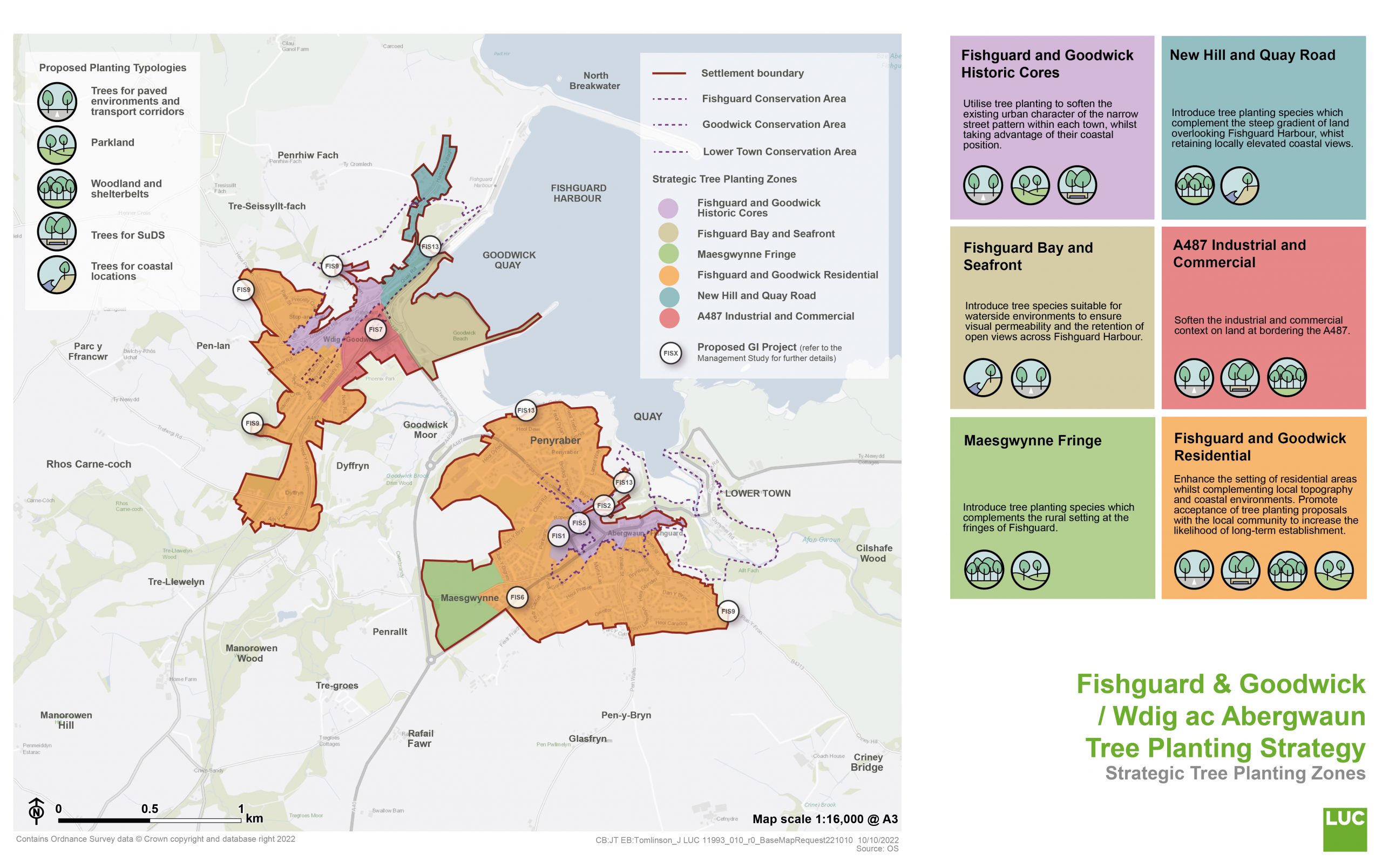- Review landscape management practices to ensure the retention of panoramic harbourside views at key locations along the Slade and Penslade in Fishguard. Longer distance views towards the wider coastline, the hills of Dinas and Newport to the North should also be restored at strategic locations along the footway.
- Promote the integration of tree planting, particularly in locations where there is little presence of trees to promote a positive contribution to townscape character. Whilst trees are not a defining characteristic of the historic urban areas and town centre (such as Fishguard High Street / West Street), opportunities should be sought to soften the built environment. Tree planting should enhance and not detract from the setting of heritage assets and distinctive street pattern within Fishguard and Goodwick Conservation Areas. Tree planting proposals should have regard to the orientation of existing built features. This includes responding to the pattern of the streetscape in terms of bays and ‘nodes’ which break up the façade.
- Due to the distinctive nature of the topography in Fishguard, tree planting proposals should be sensitively integrated along High Street and Kensington Street in order to retain the availability of long distance views. Similarly, the hillside setting of Goodwick significantly contributes to the character and setting of the town and long distance views should be conserved. Tree planting along the length of narrow streets will generally be inappropriate. Trees may be best placed at key entrances, fringes and nearby wider junctions leading into the Conservation Area boundaries, utilising trees with a narrow form to maintain sightlines where needed.
- Tree planting should be used to add interest and diversity to any areas incidental green space within built up areas (such as at Fishguard one way system). Planting several additional large parkland trees within Lota Park should be prioritised as a key opportunity, diversifying the range of species.
Fishguard and Goodwick Tree Planting Zones and Sub-Principles
Tree Planting Zones and Sub-Principles for Fishguard and Goodwick are shown on the map and drop down list below. Click on the headings to expand.
Fishguard and Goodwick Strategic Tree Planting Zones - Download image

×![]()
Fishguard and Goodwick Strategic Tree Planting Zones
Zones and Sub-Principles
Land encompassed within Fishguard Conservation Area (CA), Goodwick CA and Lower Town CA includes the spaces between buildings and existing trees within the designation. All planting proposals and management of existing trees located within and adjacent to Conservation Areas should be planned in consultation with both the Historic Building Conservation Officer and Landscape Officer at PCC.
- Use tree planting to frame routes to and from Fishguard and Goodwick, at The Parrog.
- New planting should include renovation of existing ornamental planting areas and tree groups, incorporating ornamental trees to provide aesthetic interest and diversify the range of species.
- Ensure trees are selected and managed to maintain views to the bay and for safety, raising canopies where appropriate.
- Use trees to mark routes and entrances towards key facilities and seating areas, such as the play area, aquarium and car park.
- Ensure tree species are appropriately selected to withstand the exposed location.
- Where possible, place trees to screen views of infrastructure and industrial buildings associated with the ferry port.
- Use tree planting to mark the entrance to Fishguard from the north, utilising open roadside verges for low density tree planting along the edges of adjacent agricultural land.
- Use tree planting to soften the interface between surrounding rural areas and the urban fringe, seeking opportunities to engage local landowners.
- Connect and buffer existing shelter belts and small parcels of woodland by gapping up and thickening existing field boundaries; creating corridors between the urban forest and wider landscape.
- Utilise tree planting to enhance the setting of residential streets and complement views in more elevated areas. Sufficient consideration should be given to species selection, ultimate canopy size and maintenance requirements to promote long-term establishment and reduce interference with buildings and services (e.g. telegraph lines / lighting columns).
- Avoid proposals which conflict with private vehicular access points on residential streets.
- Prioritise tree planting in areas with the least site constraints, such as larger areas of amenity grassland and verges (e.g. around Stop and Call).
- Use tree planting to buffer and screen busy route corridors nearby residential areas (e.g. A487), utilising roadside verges for avenues or small groups of trees where appropriate. Where possible, incorporate trees within Sustainable Urban Drainage Systems or swales to reduce surface water run off from roads.
- Tree planting proposals should avoid obstruction of highways, footpaths of Public Rights of Way (PRoW) within the residential context.
- Promote community ownership of proposed tree planting to increase the likelihood of long-term establishment.
- Tree planting at elevated, hilly residential areas should be low density, focussing on appropriately locating individual trees or small groups to compliment local topography. Key views towards the quay, harbour and local heritage assets should be maintained.
- Use tree planting to enhance the urban fringe and help reduce the visual impact of built development. Create links and buffer adjacent habitat areas and peri-urban woodlands, engaging with surround landowners where possible.
- Utilise tree planting to screen and soften industrial and commercial areas.
- Prioritise planting in areas with least constraints and ‘quick win’ locations, including the boundaries of adjacent open spaces (e.g. Phoenix Park, Wern Road).
- Incorporate tree planting at Phoenix Road Car Park, utilising perimeter verges and greening the expanse of hard landscape. Avoid fruit bearing trees in areas where this may cause a nuisance.
